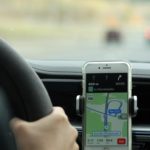Distracted Driving
Distracted driving is any non-driving activity a motorist engages in that has the potential to distract them from the primary task of driving.
Types of DISTRACTIONS While all distracted driving is dangerous, texting is the most alarming because it involves all three types of distraction at the same time. In order to reduce the risks associated with distracted driving, it is the policy of Allegheny College to prohibit the use of cell phones (unless hands free/bluetooth) or any other mobile device while operating a motor vehicle while on college business.
 There are many common activities likely to distract someone from driving. Common distractions that lead to crashes include
There are many common activities likely to distract someone from driving. Common distractions that lead to crashes include
Driver Safety – Cell Phones
 Not a safe practice! Operating a motor vehicle safely requires concentration, focus and awareness of constantly changing surroundings. Talking on a cell phone can take your focus away from the road and increase the risk of accidents. On average, a person is four times more likely to be in an accident when talking on a cell phone.
Not a safe practice! Operating a motor vehicle safely requires concentration, focus and awareness of constantly changing surroundings. Talking on a cell phone can take your focus away from the road and increase the risk of accidents. On average, a person is four times more likely to be in an accident when talking on a cell phone.
More and more states have passed laws that prohibit hand-held cell phone usage while driving. Check with your local jurisdictions to determine if any cell phone restriction laws are present. Regulations vary from state to state, but a PA ban on text messaging while driving took effect March 8, 2012
Important guidelines: Do not use your phone in poor conditions: Poor driving conditions or low light situations can severely affect your reaction and response time. Using a cell phone when driving at night or in rainy situations is not recommended. This is the notion of driving with accident prevention in mind. A defensive driver keeps a watchful eye out for potential hazards and does not rely on other drivers to compensate for their mistakes. This style of driving is critical for maintaining safety on the roadways. “Defensive driving” should not be confused with “defensive” driving, which adds unnecessary risk to an already dangerous activity. “Defensive” driving usually occurs when people begin to take the actions of other drivers as personal assaults. This kind of behavior has many names, but the product is always the same: drivers get distracted by emotions and competition, rules are broken and accidents occur. Simple common courtesy is an effective deterrent for “defensive” driving. Always drive with accident prevention in mind:
Driver Safety – Being Courteous
“Defensive Driving”:

“Defensive” driving – There is a big difference!
 You are on the freeway, driving along in normal traffic conditions. Suddenly, a car in an adjacent lane signals that they would like to move over. You notice the blinking light and think to yourself, “So this person thinks they can just cut me off?” You angrily speed up to close the gap between you and the car you are following.
You are on the freeway, driving along in normal traffic conditions. Suddenly, a car in an adjacent lane signals that they would like to move over. You notice the blinking light and think to yourself, “So this person thinks they can just cut me off?” You angrily speed up to close the gap between you and the car you are following.
Best practices for “Defensive Driving”: